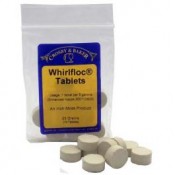 I’ve been struggling with clarifying my beer lately and came across some interesting info on using Whirlfloc. According to this thread, Whirlfloc wasn’t really intended to be used in homebrewing. But the manufacturer suggested when using Whirlfloc, add it to the last 5 minutes of the boil. Also, if you’re doing 5 gallon batches, 1/2 tablet is all you need.
I’ve been struggling with clarifying my beer lately and came across some interesting info on using Whirlfloc. According to this thread, Whirlfloc wasn’t really intended to be used in homebrewing. But the manufacturer suggested when using Whirlfloc, add it to the last 5 minutes of the boil. Also, if you’re doing 5 gallon batches, 1/2 tablet is all you need.
Tag Archives | proteins
Coagulated Proteins
I’ve been running into problems with my last few batches of beer. I would use Whirlfloc in the last 15 minutes of the boil to coagulate the proteins. The thought is to clarify the beer. Then I dump the wort into the primary (I have been doing partial 3 gal boils for 5 gallon batches). But when I move the beer to the bottling bucket, I get a ton of coagulated proteins transferred which eventually makes it to my bottle. As such, when you pour your beer, you have these crazy floating things. Probably both yeast chunks and proteins.
I thought maybe my problem is that I’m pouring all the contents of the brewpot into the fermenter. Perhaps if I can keep most of it behind in the brewpot, the rest would settle out in the primary. So, for my latest batch (Zuul Drool Brown Ale), I tried something different. Instead of dumping, I’ll use my auto-siphon to transfer to the primary. After cooling the wort, I stirred the wort to create some centripetal force and let it set for 30 minutes. My understanding is that it will condense the heavy particulates in the center. Then I can siphon off the edges, avoiding the goo.
Well, this worked for the first half of the wort transfer. Perfectly clear. But then I got toward the bottom. The last 1/4 of the wort was coagulated proteins, which looked like gelatin. If I left this behind, I’d lose out on a lot of beer.
In the end, I poured all the wort into the primary. I just bought a carboy to use as a secondary (up unitl now, I just used the primary). So hopefully between the two, it will clear up and I can leave that gunk behind.
This is really bugging me, so I asked in the Home Brew Talk forums (you can read some of the responses here). I also shot James from Basic Brewing an email asking his opinion. I’ll update this post as I get things figured out.
Update 12/2/2011: According to the forum thread I posted, this coagulated proteins is considered cold break. Now that I know the term, it will be easier search for the solution. Right now, it seems the best solution is to transfer to primary and let it settle out. Then transfer to secondary for additional clarification. We’ll see what others have to say.
